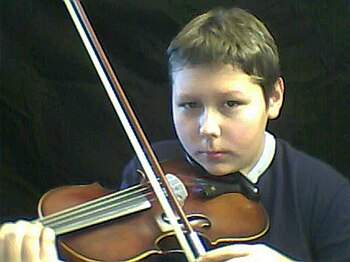 Violin made in about 1770. (1) Chinrest (2) Tailpiece (3) Bridge (4) Strings (5) Fingerboard (6) Fine-Tuner (7) Sound hole (8) Corner (9) Purfling (10) Body (11) Rib (12) End Button
Violin made in about 1770. (1) Chinrest (2) Tailpiece (3) Bridge (4) Strings (5) Fingerboard (6) Fine-Tuner (7) Sound hole (8) Corner (9) Purfling (10) Body (11) Rib (12) End Button
(Photo credit: Wikipedia)
In order to correctly play the violin you will need to know what all the parts are. In this article I will teach you the names of the major ones from the top of the violin to the bottom (not in the order of the picture).
- Scroll - This is the decorative part located at the very top of the violin they are mostly hand carved.
- Tuning pegs - These are used to tune the violin, by adjusting them up or down you can tune your violin.
- The Nut - This supports the strings and keeps them away from the fret board.
- Fingerboard - This is the strip of wood on the neck of the violin where the strings are this is also the area where you play or finger the notes.
- The Strings - The violin has four strings tuned a fifth apart from thickest to thinnest they are G, D, A and E.
- The Bridge - This holds the strings in place it is essential as its placement affect the quality of the sound produced by the violin.
- F Holes - These are on either side of the bridge and allow the sound of the vibrating strings to resonate. They are called f holes because they are shaped like an f in italics. Altering the F hole can affect the sound of the violin.
- Tail piece - This is the part that anchors the strings to the violin.
- Chin Rest - This helps the violinist hold the instrument in place while playing the violinist can use their chin to hold the violin freeing up their hands.
Article Directory: EzineArticles |


